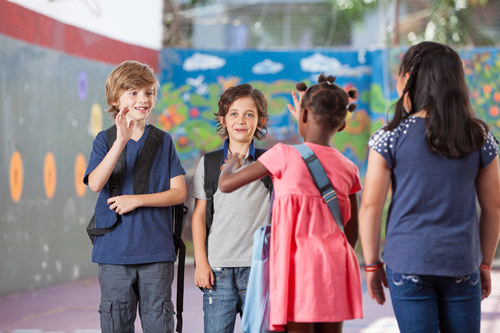These days, words like bullying, isolation, suicide, peer pressure, and anxiety are more and more commonly used among students, parents, and educators. As educators, we hear these words and experience the reality of each. I’m reminded of a time when the expression, “Can’t we all just get along?” was first spoken during the height of gang wars in Los Angeles, when I was a new speech language pathologist in the Los Angeles Unified School District.
More than 30 years later, I now work at a 700-student elementary school in Washington state and I have a caseload of 50 students consisting of varying disabilities. Here, the topic of social-emotional learning (SEL) and those super-charged words are at the forefront of my caseload. As we forge ahead in 2019 and beyond with the goal of helping each student learn to his or her full potential, it’s more important than ever to address SEL.
Here are five ways our school has developed better SEL skills in our students and how you, too, can build positive social-emotional learning into everything you do in small group settings with all students. I keep these on my desk as a reminder and repeatedly go over them in my head as I start each new day.
1. Address ALL students you encounter with eye contact in conjunction with saying their name.
Eye contact and knowing names are two of the most important steps in building relationships. Adding a smile throughout the week when you see students on campus lets them know you see them and you care.
2. Ask relevant questions that are specific to their interests.
Take time to ask questions about activities, events, or people and things you have in common. This fosters relationship building, trust, and tells them you’re available and care about what matters to them.
3. Affirm by saying five positive comments to every negative comment spoken during your sessions.
Encourage students to compliment each other directly. Everyone deserves to hear something good about themselves, and when asked to do so directly, everyone can find something good to say about someone else. Additionally, encourage and model the positive behaviors that you’re demonstrating.
4. Align your words and material to specify the focused target.
It’s important to select resources that model and reinforce the behaviors you want students to learn. Fortunately, there are a number of excellent ways to incorporate examples of good behavior and kind reactions. I look for board and card games (and other hands-on activities using dice and markers) to encourage discussion and collaboration. This allows opportunities for students to interact and show patience and tolerance, especially if the game is not going their way. I use this time to observe, interject, and create teachable moments.
For me, technology has been one of the most salient tools I use every day. I use movies and video modeling webisodes, which offer invaluable chances to show my students what to look for (identifying overt and less obvious negative and positive behaviors), how to interact positively, and why it’s harmful or beneficial to everyone involved and next steps.
For this exercise, I use The Social Express, which was developed by Marc Zimmerman, the father of twin autistic boys. As Zimmerman created The Social Express to help his sons navigate the social-emotional situations they were facing, he decided to design other resources as well, all of which would help kids become more empathic, tolerant individuals who can manage their emotions, respond positively, and avoid classroom behavior incidents that cause disruption. Like The Social Express, his Cool School program uses interactive webisodes that model good behavior and illustrate different skills. I rely on The Social Express’s webisodes and lessons focused on self-management, group participation, active listening, conflict resolution, and more. Viewing lessons online that model good behavior in these areas is a good way to get into your students’ wheelhouse in a safe and fun way.
5. Allow yourself to think outside the box.
Be creative in developing other opportunities in which your students can regularly participate. For example, we created the Ambassadors Group, designed for grades 1-3. Each month, teachers select new volunteers. Each Ambassador is located by a major entrance to the school, where they open doors for staff, parents, and students and are responsible for a friendly welcome greeting for each person they encounter. This has been a fantastic tool for our students. They see it as a reward and an honor, and it also positive interactive time to encourage social perspective with students at your school. Later, we discuss situations and events that arise from each child’s turn as Ambassador and provide positive reinforcement, critique, and plenty of praise.
This year is off to a great start, and I’m doing my best to review this list and bring my A game to every interaction. It’s important for us all to improve SEL and transform our students, but the greater reward is connecting with your students in a meaningful way and helping them connect with others, which results in self-confidence, increased joy in learning, improved academic success, and better classroom management
What more could an educator want?
- 4 ways to encourage play in education - April 25, 2024
- CoSN IT Leader Spotlight: Lisa Higgins - April 25, 2024
- It’s time to pay student teachers - April 25, 2024


